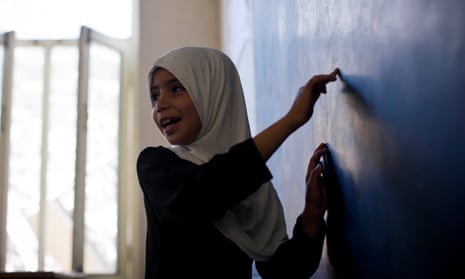World leaders have “a lot to answer for” as new figures reveal that governments are failing to give all children an education, and that by 2030 one in six children won’t be in school.
The former prime minister of New Zealand and advocate for education Helen Clark said the figures showed “worrisome complacency on the part of countries which, just a few years ago, were so keen to hammer out an ambitious global agenda and make it a success”.
“Education is slipping down the aid agenda when it should be rising up,” Clark said.
As part of the sustainable development goals, UN members states promised that all children would complete free, equitable and quality primary and secondary education.
But Unesco predicts that by the 2030 deadline, one in six children aged six to 17 still won’t be in education, including one in 11 primary school-aged children.
Taking stock of progress a third of the way towards the deadline for a high-level political forum on sustainable development in New York this week, Unesco analysed responses by 72 governments and key city or municipal authorities, concluding that without a significant acceleration, the world will miss its education commitments.
Researchers found that as well as children continuing to miss out on the chance to go to school, many who do start education are still dropping out. By 2030, they predict that 40% of young people will still not complete secondary education.
“Considering that ‘a good quality education’ was voted young people’s most important priority in 2015 when the SDGs were being decided, leaders today have a lot to answer for. Countries must commit to investing more in education now so that we do not break the global promise made to today’s children and youth,” said Clark, who is chair of the Global Education Monitoring Report advisory board.
“Today’s warning [on the education goal] has worrying implications for the whole 2030 agenda on sustainable development. It’s never too late to act to correct course, but doing so is now urgent if the global agenda is to be achieved.”
Quick GuideWhich countries stand out in the education report?
Show
Ethiopia: strong progress for girls
- 27% of national budget spent on education – the second highest proportion of any country in the world
- Incentives for girls to complete primary education before reaching puberty, when marriage and pregnancy can interrupt schooling
- Strong campaigning has led to a reduction in early marriage of more than 20% between 2005 and 2011
Nepal: increase in trained teachers
- 50% increase in trained teachers from 2000-2015, 60% of new teachers are female
- There are now more girls than boys going to primary school
- Only country surveyed that showed advances in adult literacy rates
Afghanistan: rise in education spend per pupil
- On course to triple primary completion rates from 2000 to 2030
- Dramatic increase in spend per primary child, from $13/child in 2002-2004 to $186/child in 2017
- Increase in aid for education. Canada has funded, for example, more village-based schools to reduce the distance pupils have to travel, which was found to increase attendance of girls in particular
Liberia: at risk of stagnating
- Many teachers left the country or took other work following a 14-year civil war and school closures during the Ebola outbreak
- Fewer than half of current primary school teachers are trained
- 7% of budget spent on education, compared with an average of 16% elsewhere in the region
Gordon Brown, former prime minister and the UN’s special envoy on global education, said: “Once again new projections by Unesco show that we are failing our youth by not guaranteeing access to quality education … We need to do more to support and encourage countries to commit to education, which is key to healthy societies.”
In 2018 Brown launched the $10bn (£8bn) International Finance Facility for Education, backed by the UN and the World Bank. He emphasised the need to continue to develop new streams of financing “to provide the means to invest and reform education systems. There is no time to waste.”
Unesco’s snapshot of the global state of education also highlights ongoing inequalities.
While literacy rates are improving globally, within low-income countries, projections show that about 20% of young people and 30% of adults will still not be able to read by 2030. An estimated 750 million adults cannot currently read.
In low-income countries, only 4% of the poorest finish upper secondary school and only 2% among the poorest girls, compared with 36% of the richest.
Many governments are adopting policies to try to meet their commitments, including in early and life-long learning, but funding remains an issue.
A report on the second sustainable development goal, Zero Hunger, will be launched on 15 July, and the forum concludes with ministerial meetings from 16-18 July.
